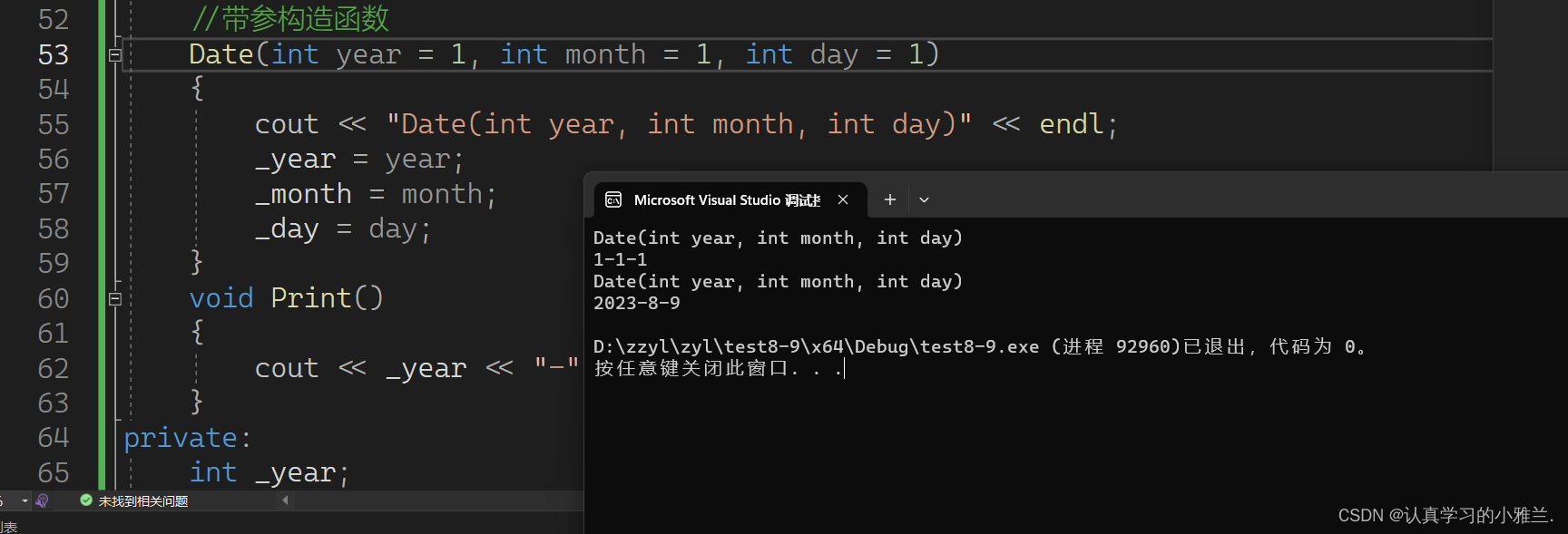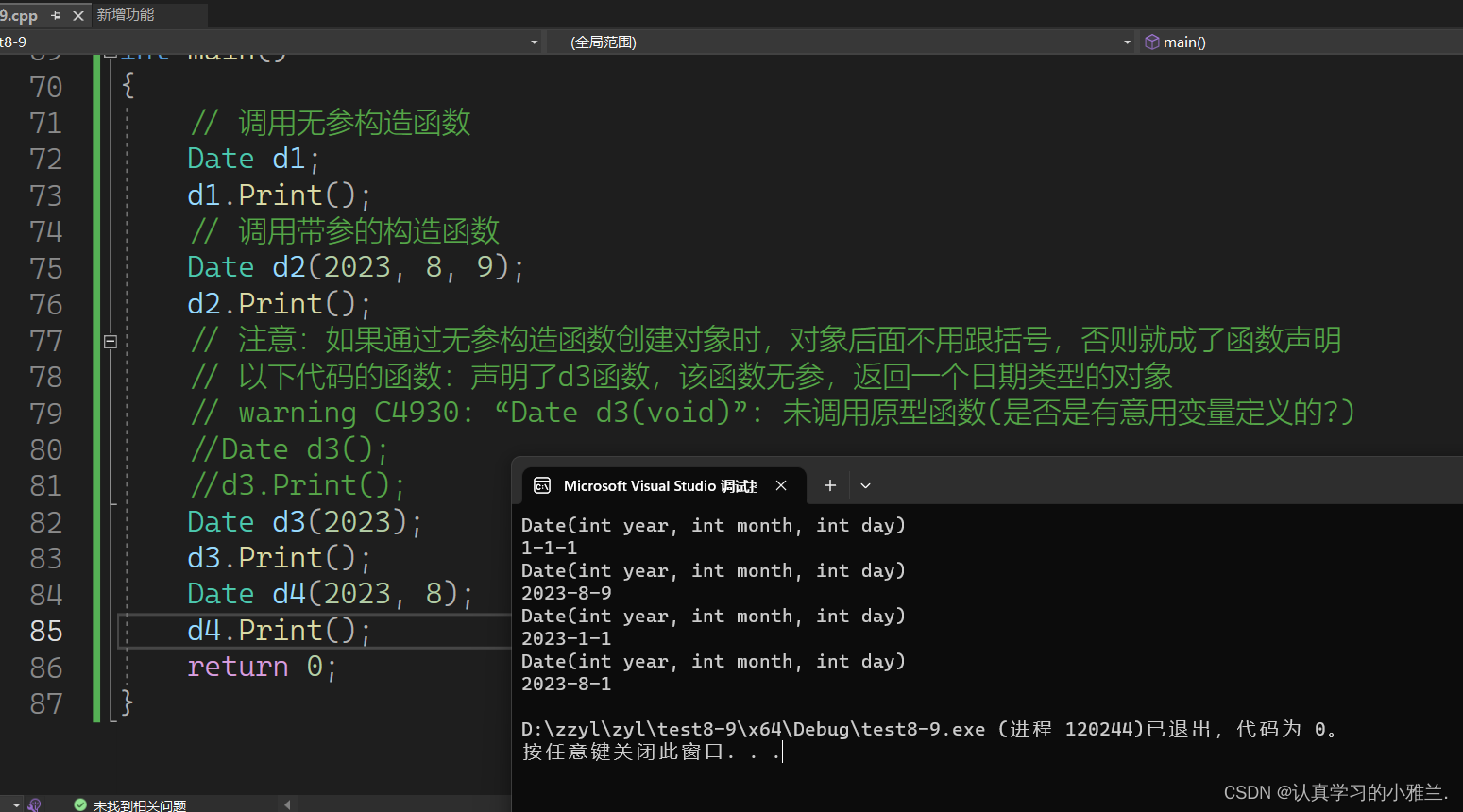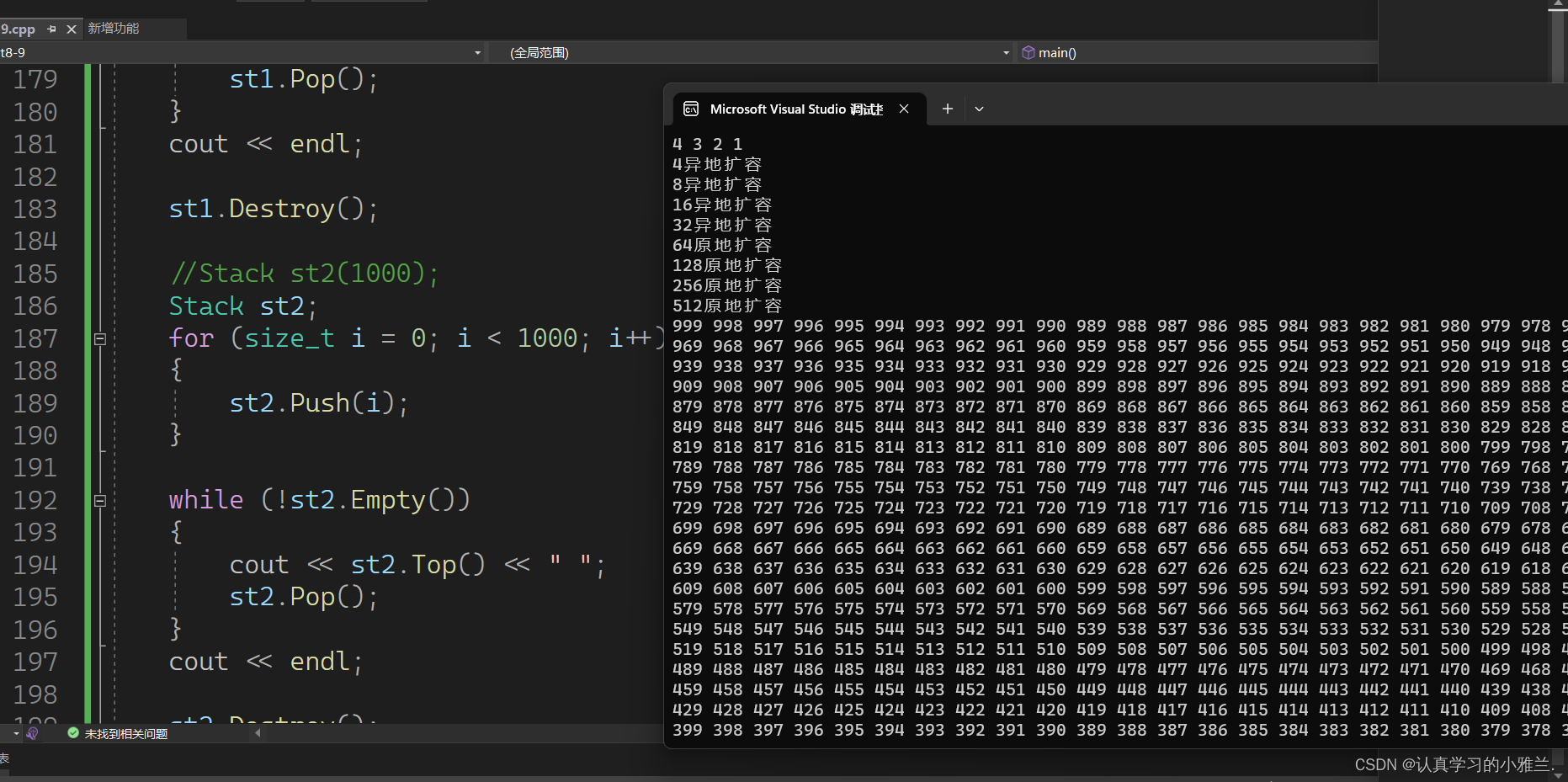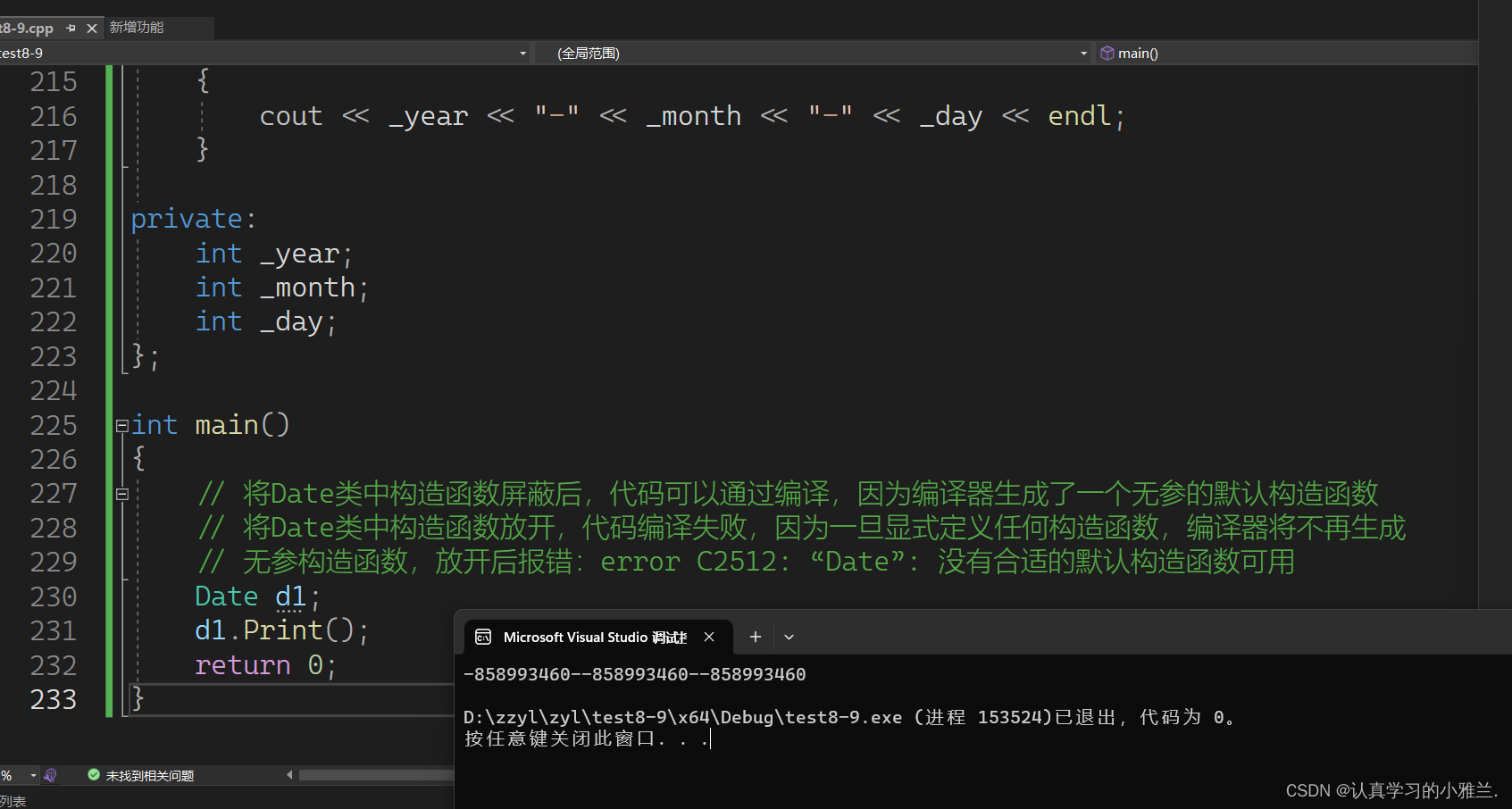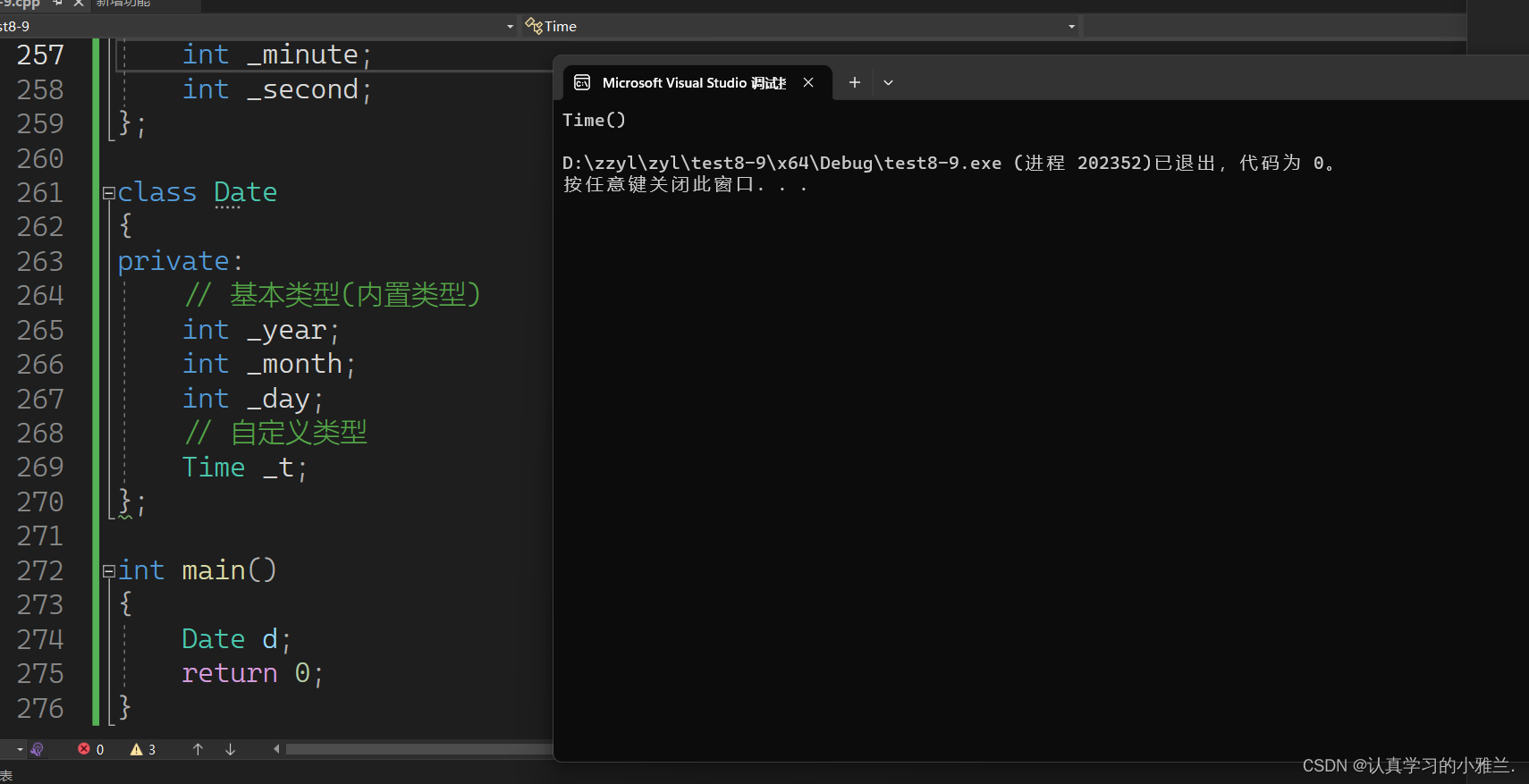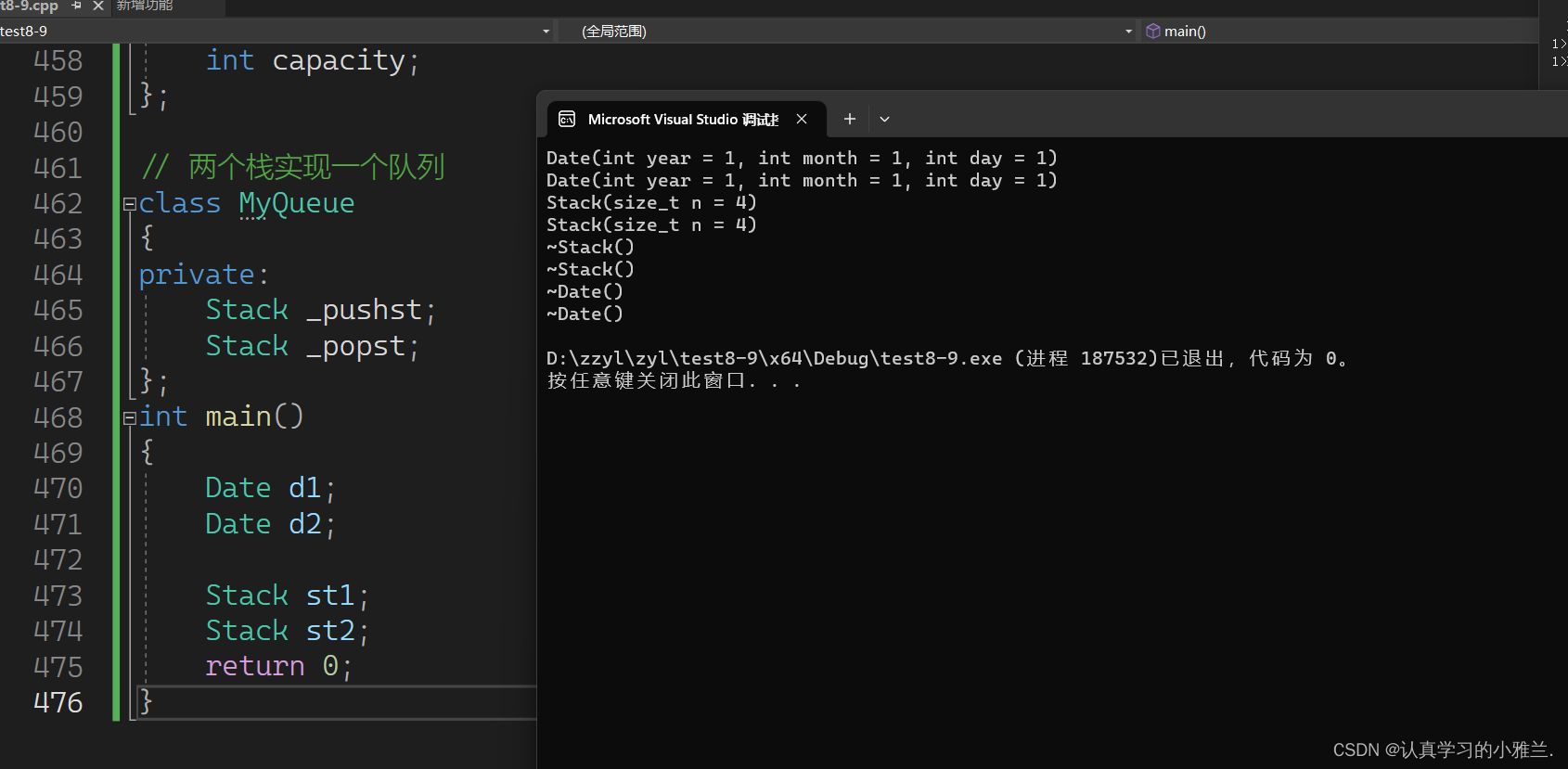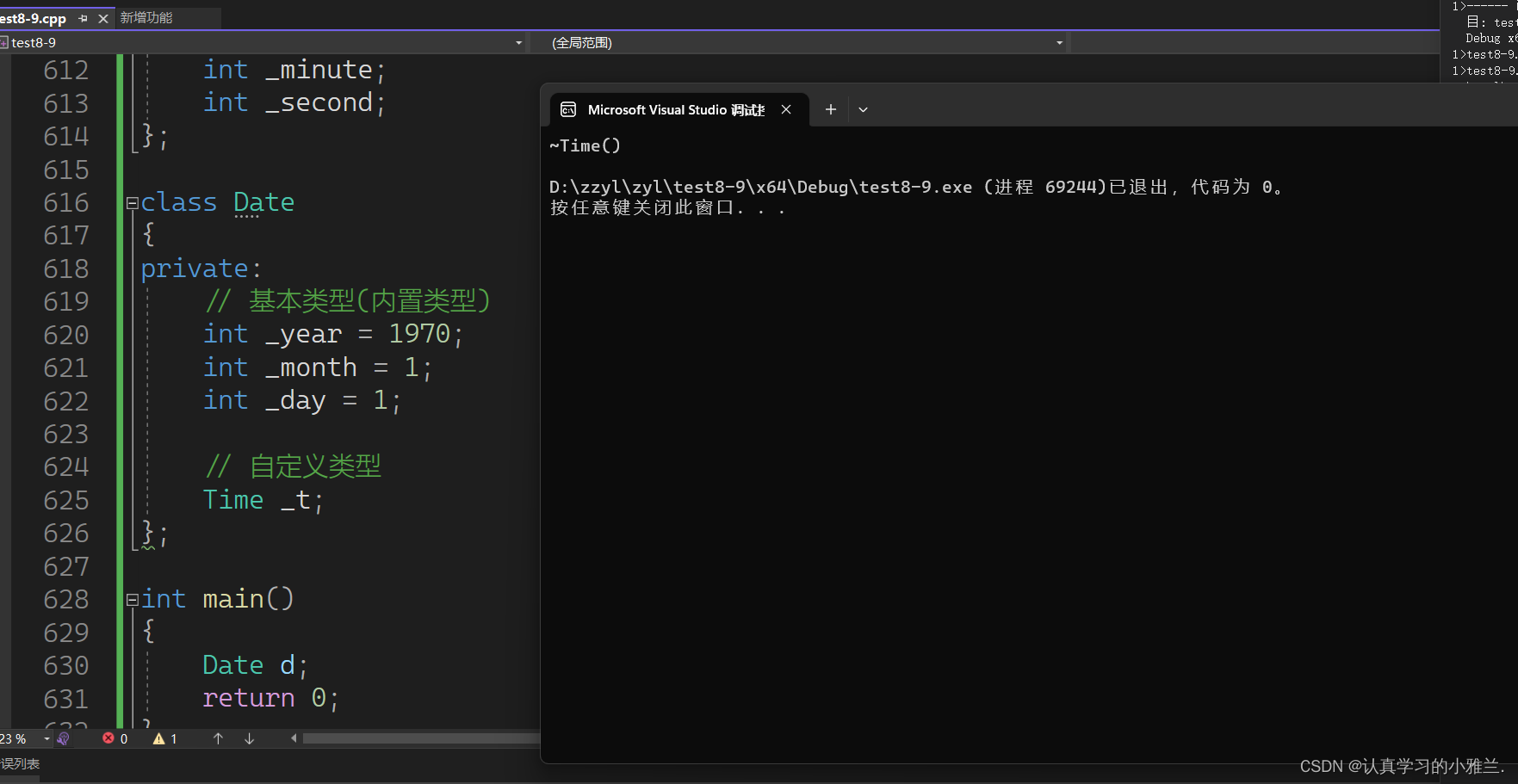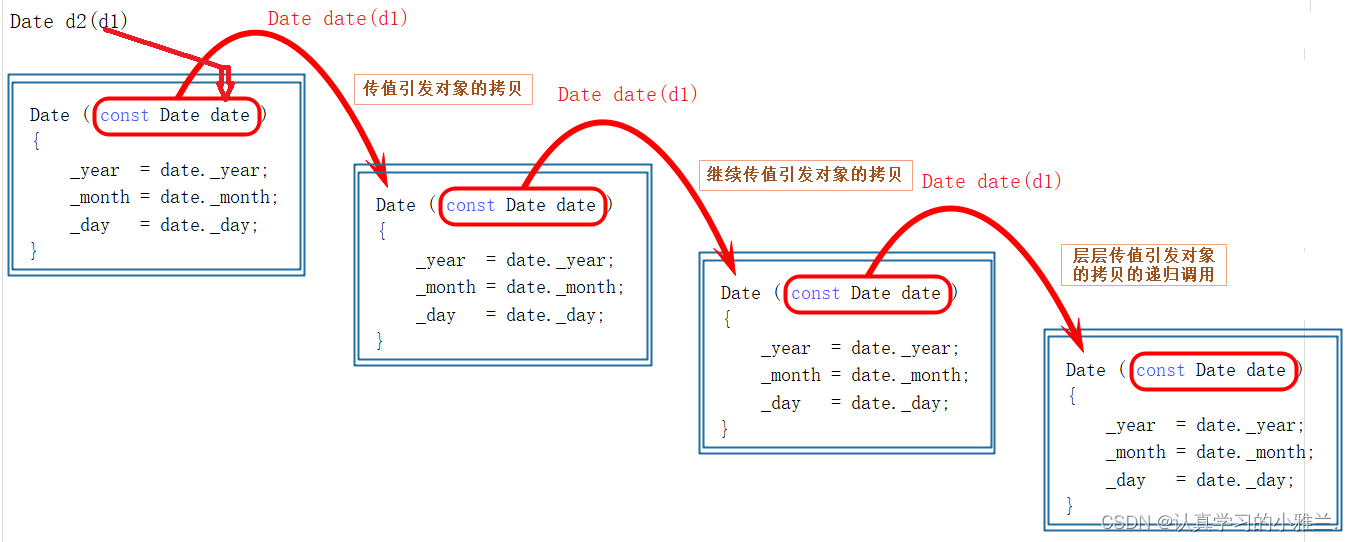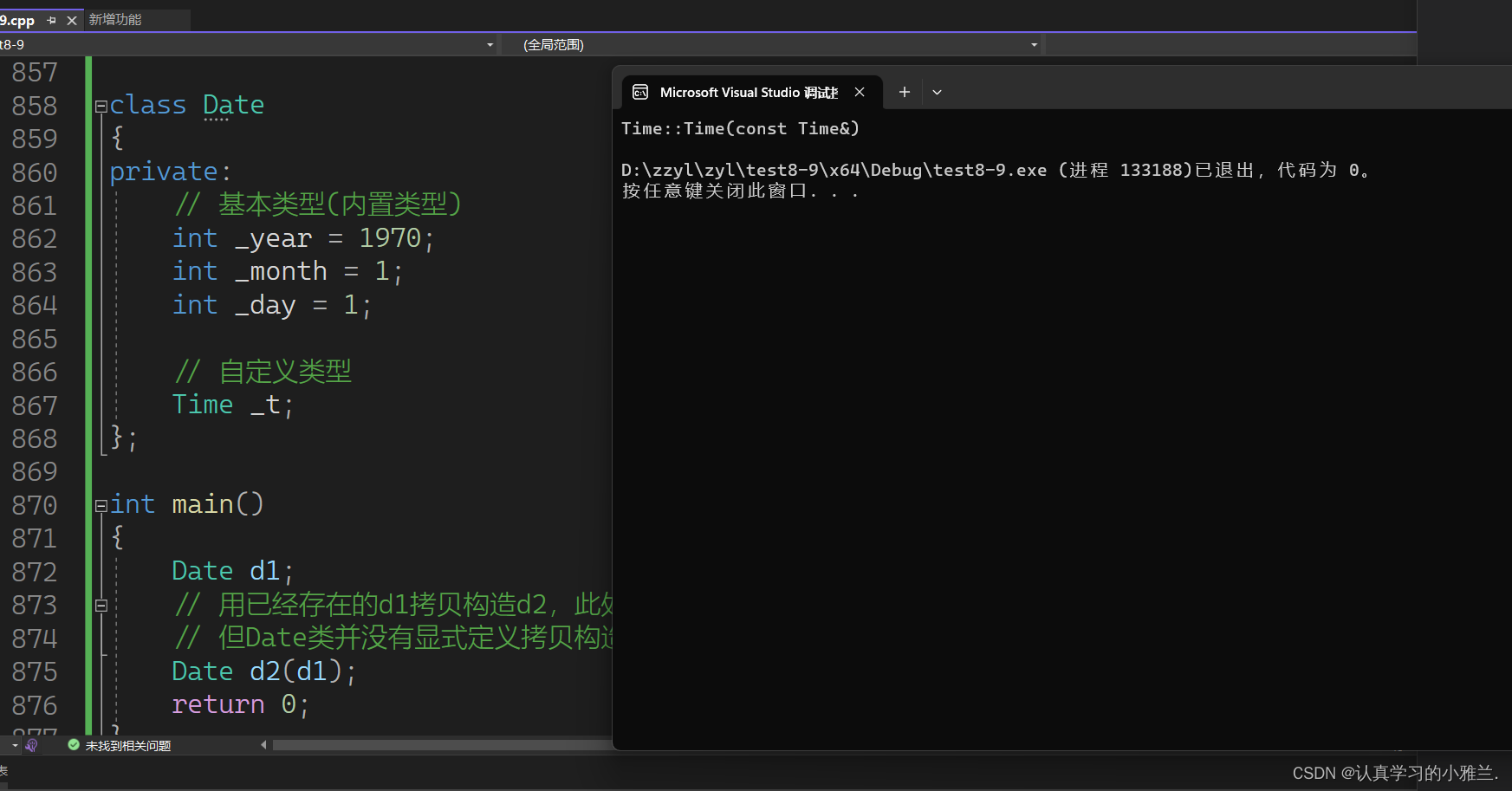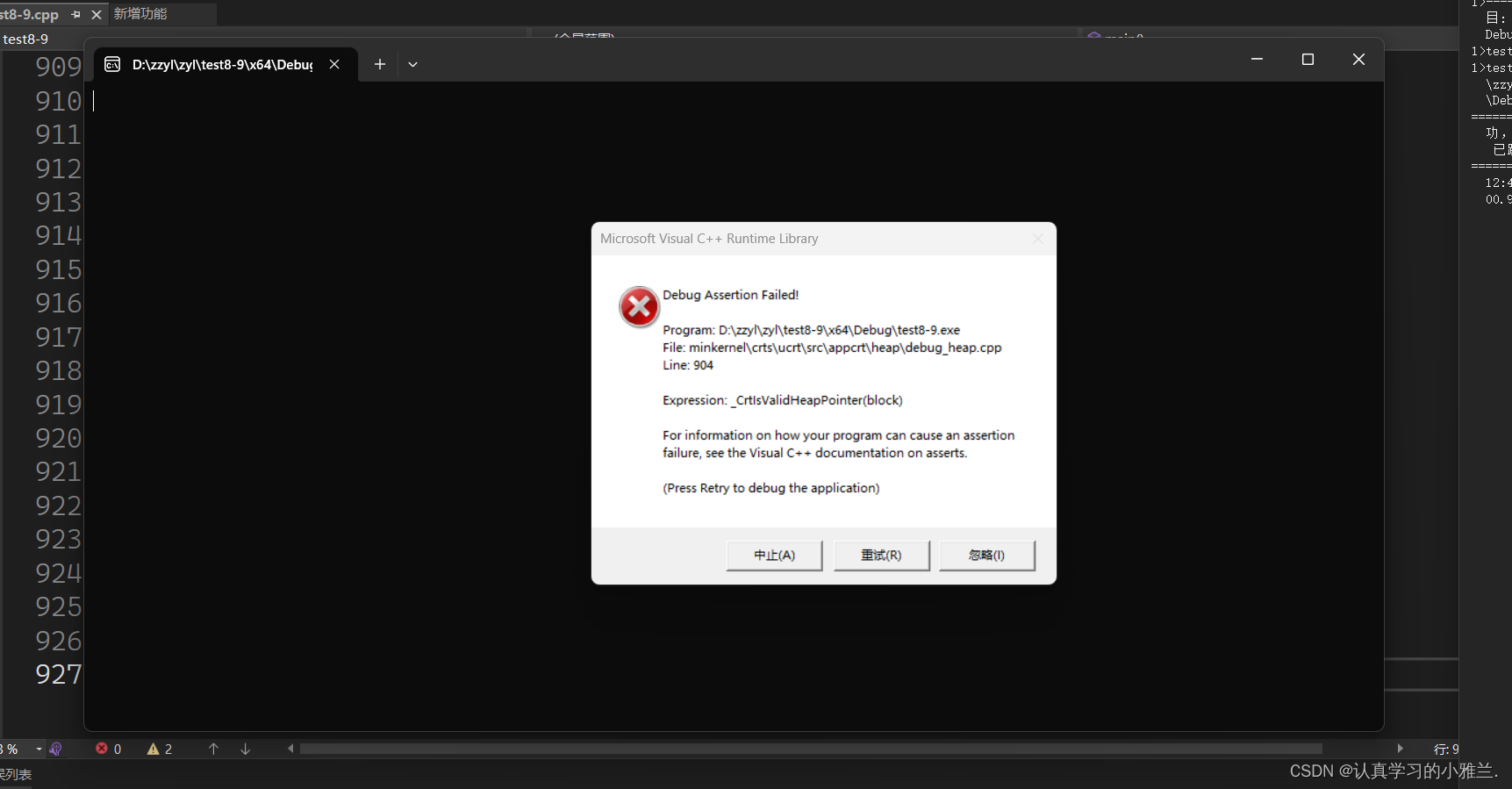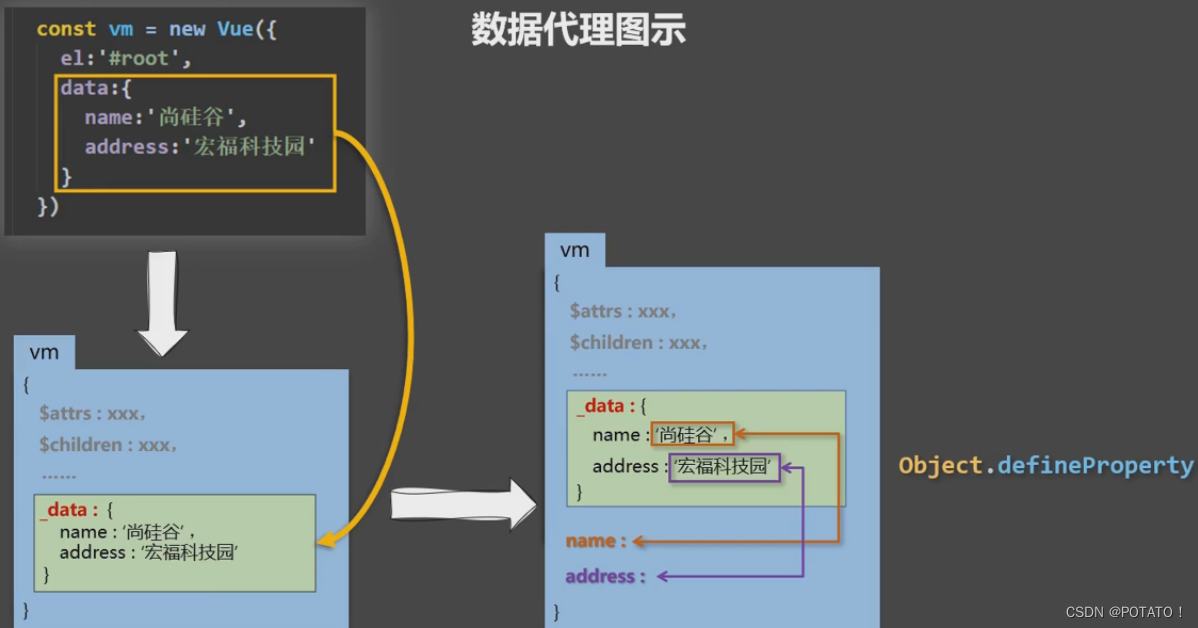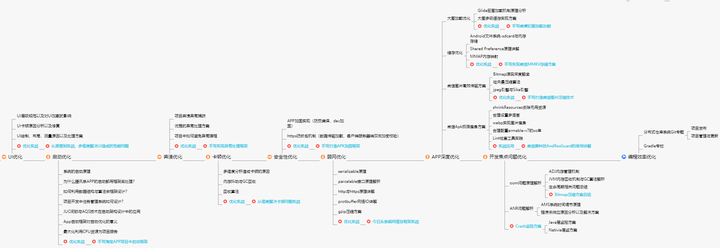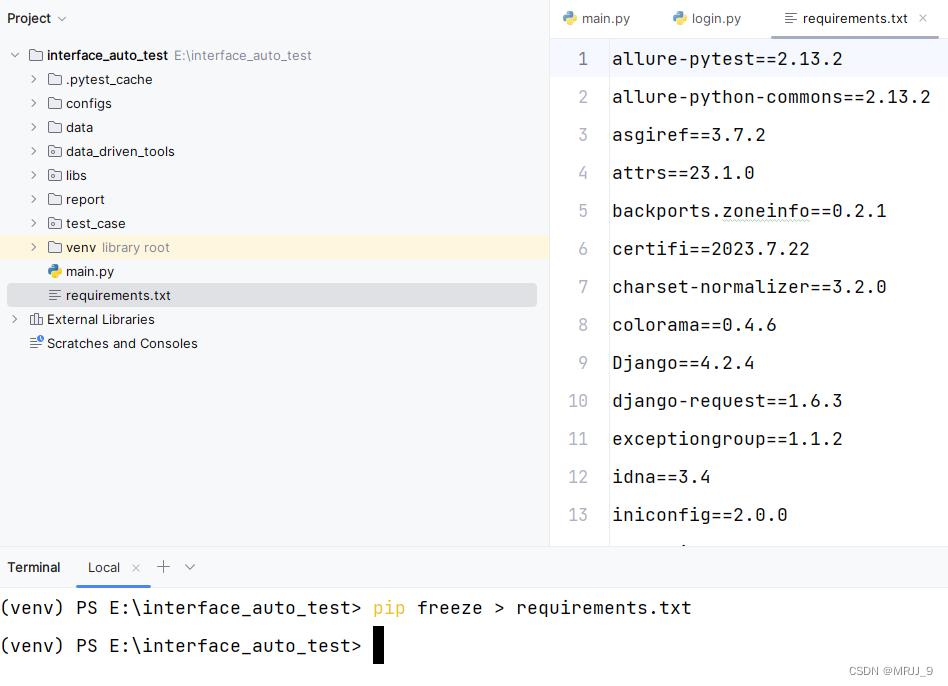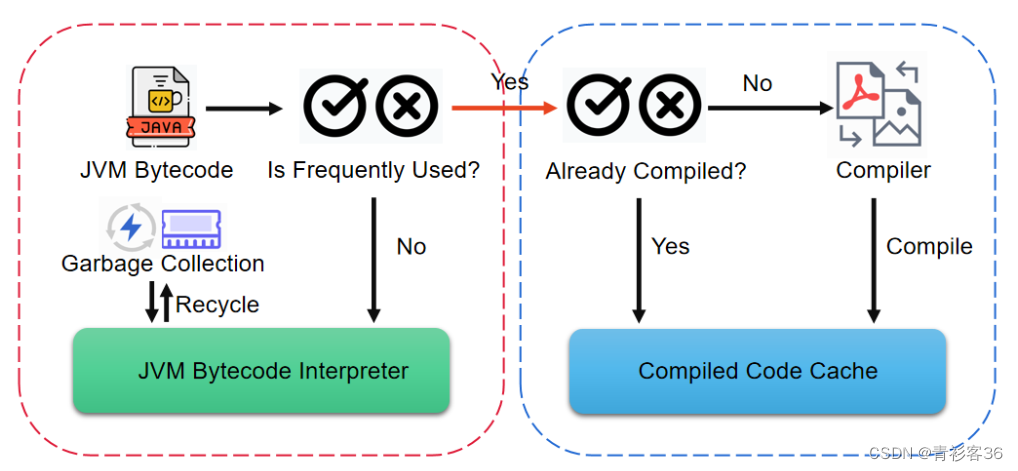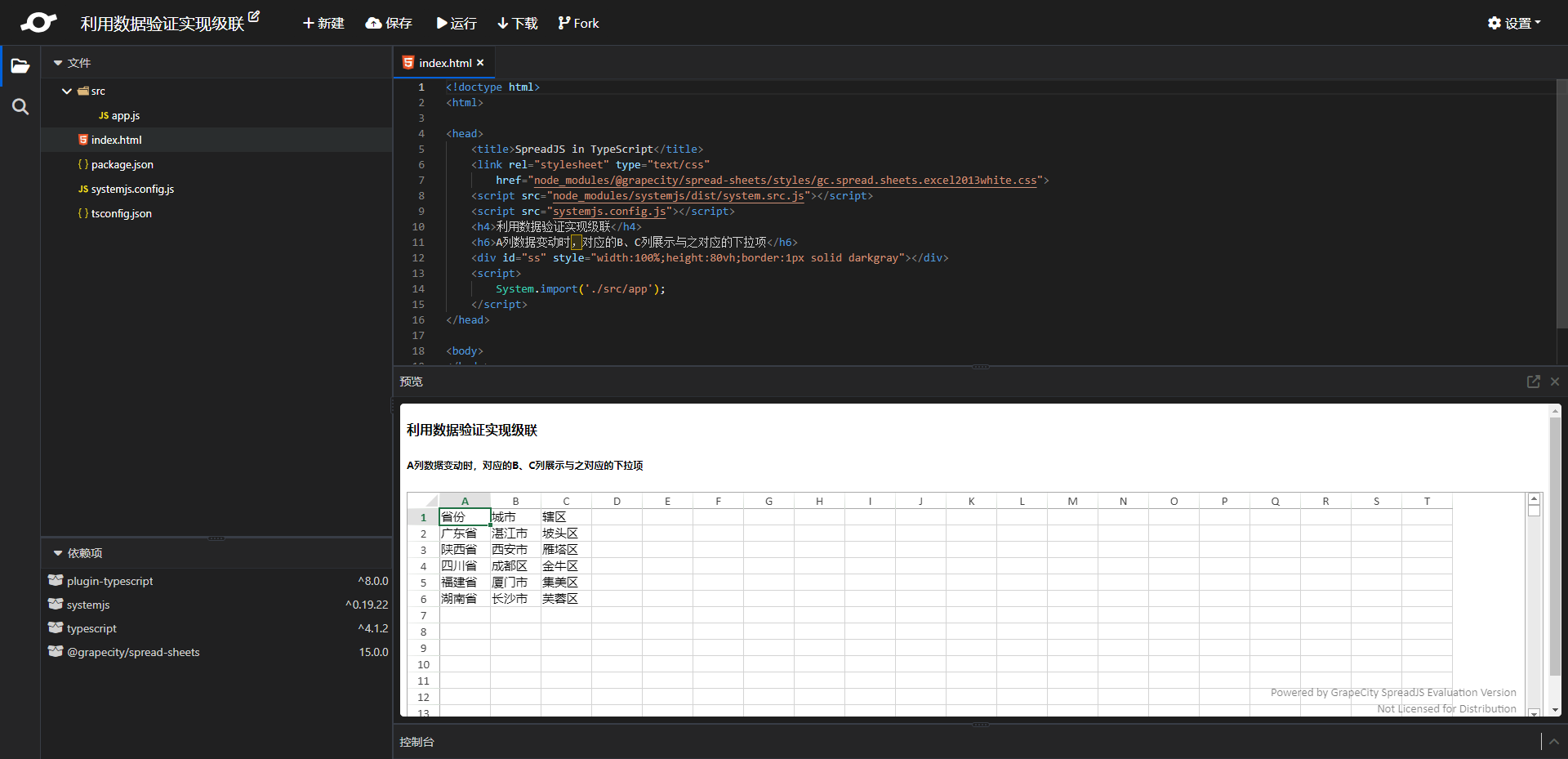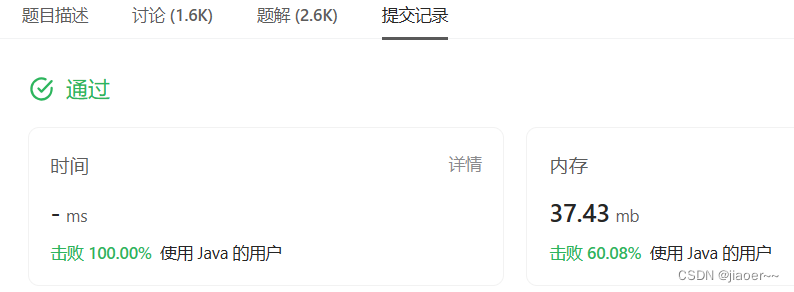各位CSDN的uu们好呀,好久没有更新小雅兰的C++专栏啦,话不多说,让我们进入类和对象的世界吧!!!
类的6个默认成员函数
构造函数
析构函数
拷贝构造函数
类的6个默认成员函数
如果一个类中什么成员都没有,简称为空类。
空类中真的什么都没有吗?并不是,任何类在什么都不写时,编译器会自动生成以下6个默认成员 函数。
默认成员函数:用户没有显式实现,编译器会生成的成员函数称为默认成员函数。
class Date {};

构造函数
概念
对于以下Date类:
#include<iostream> using namespace std; class Date { public: void Init(int year, int month, int day) { _year = year; _month = month; _day = day; } void Print() { cout << _year << "-" << _month << "-" << _day << endl; } private: int _year; int _month; int _day; }; int main() { Date d1; d1.Init(2023, 8, 9); d1.Print(); Date d2; d2.Init(2023, 8, 10); d2.Print(); return 0; }对于Date类,可以通过 Init 公有方法给对象设置日期,但如果每次创建对象时都调用该方法设置信息,未免有点麻烦,那能否在对象创建时,就将信息设置进去呢?
构造函数是一个特殊的成员函数,名字与类名相同,创建类类型对象时由编译器自动调用,以保证每个数据成员都有 一个合适的初始值,并且在对象整个生命周期内只调用一次。
特性
构造函数是特殊的成员函数,需要注意的是,构造函数虽然名称叫构造,但是构造函数的主要任务并不是开空间创建对象,而是初始化对象。
也就是说,构造函数类比于Init函数!!!
其特征如下:
- 函数名与类名相同。
- 无返回值(不需要写void)。
- 对象实例化时编译器自动调用对应的构造函数。
- 构造函数可以重载(本质就是写多个构造函数,提供多种初始化方式)。
class Date { public: //无参构造函数 Date() { cout << "Date()" << endl; _year = 1; _month = 1; _day = 1; } //带参构造函数 Date(int year, int month, int day) { cout << "Date(int year, int month, int day)" << endl; _year = year; _month = month; _day = day; } void Print() { cout << _year << "-" << _month << "-" << _day << endl; } private: int _year; int _month; int _day; }; int main() { // 调用无参构造函数 Date d1; d1.Print(); // 调用带参的构造函数 Date d2(2023, 8, 9); d2.Print(); // 注意:如果通过无参构造函数创建对象时,对象后面不用跟括号,否则就成了函数声明 // 以下代码的函数:声明了d3函数,该函数无参,返回一个日期类型的对象 // warning C4930: “Date d3(void)”: 未调用原型函数(是否是有意用变量定义的?) Date d3(); d3.Print(); return 0; }

//无参构造函数
Date()
{
cout << "Date()" << endl;
_year = 1;
_month = 1;
_day = 1;
}
//带参构造函数
Date(int year, int month, int day)
{
cout << "Date(int year, int month, int day)" << endl;
_year = year;
_month = month;
_day = day;
}上述两个函数其实可以合并一下,写成全缺省参数的形式。
//带参构造函数 Date(int year = 1, int month = 1, int day = 1) { cout << "Date(int year, int month, int day)" << endl; _year = year; _month = month; _day = day; }
这样的写法也更灵活了,可以传一个参数,也可以传两个参数,也可以传三个参数,也可以不传参数。
再看下面这个实例:
class Stack { public: Stack(size_t n = 4) { if (n == 0) { a = nullptr; top = capacity = 0; } else { a = (int*)malloc(sizeof(int) * n); if(a == nullptr) { perror("realloc fail"); exit(-1); } top = 0; capacity = n; } } void Push(int x) { if (top == capacity) { size_t newcapacity = capacity == 0 ? 4 : capacity * 2; int* tmp = (int*)realloc(a, sizeof(int) * newcapacity); if (tmp == nullptr) { perror("realloc fail"); exit(-1); } if (tmp == a) { cout << capacity << "原地扩容" << endl; } else { cout << capacity << "异地扩容" << endl; } a = tmp; capacity = newcapacity; } a[top++] = x; } int Top() { return a[top - 1]; } void Pop() { assert(top > 0); --top; } void Destroy() { free(a); a = nullptr; top = capacity = 0; } bool Empty() { return top == 0; } private: // 成员变量 int* a; int top; int capacity; }; int main() { Stack st1; st1.Push(1); st1.Push(2); st1.Push(3); st1.Push(4); while (!st1.Empty()) { cout << st1.Top() << " "; st1.Pop(); } cout << endl; st1.Destroy(); //Stack st2(1000); Stack st2; for (size_t i = 0; i < 1000; i++) { st2.Push(i); } while (!st2.Empty()) { cout << st2.Top() << " "; st2.Pop(); } cout << endl; st2.Destroy(); return 0; }
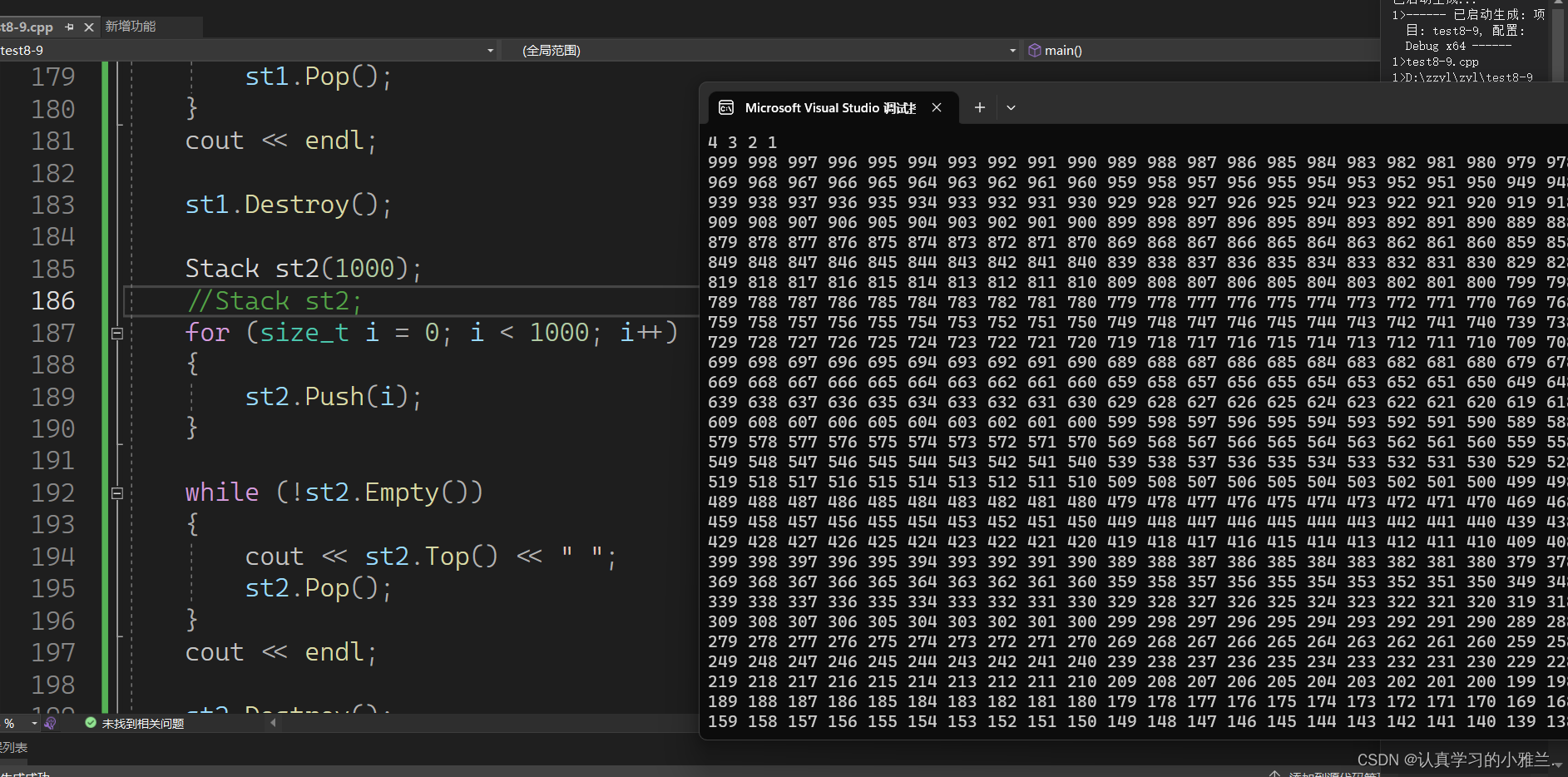
构造函数,是默认成员函数,不写,编译器会自动生成。
编译生成的默认构造的特点:
- 我们不写才会生成,我们写了就不会生成了。
- 内置类型的成员不会处理(C++11,声明支持给缺省值)。
- 自定义类型的成员才会处理,会去调用这个成员的默认构造函数。
如果类中没有显式定义构造函数,则C++编译器会自动生成一个无参的默认构造函数,一旦 用户显式定义编译器将不再生成。
class Date { public: 如果用户显式定义了构造函数,编译器将不再生成 //Date(int year, int month, int day) //{ // _year = year; // _month = month; // _day = day; //} void Print() { cout << _year << "-" << _month << "-" << _day << endl; } private: int _year; int _month; int _day; }; int main() { // 将Date类中构造函数屏蔽后,代码可以通过编译,因为编译器生成了一个无参的默认构造函数 // 将Date类中构造函数放开,代码编译失败,因为一旦显式定义任何构造函数,编译器将不再生成 // 无参构造函数,放开后报错:error C2512: “Date”: 没有合适的默认构造函数可用 Date d1; d1.Print(); return 0; }
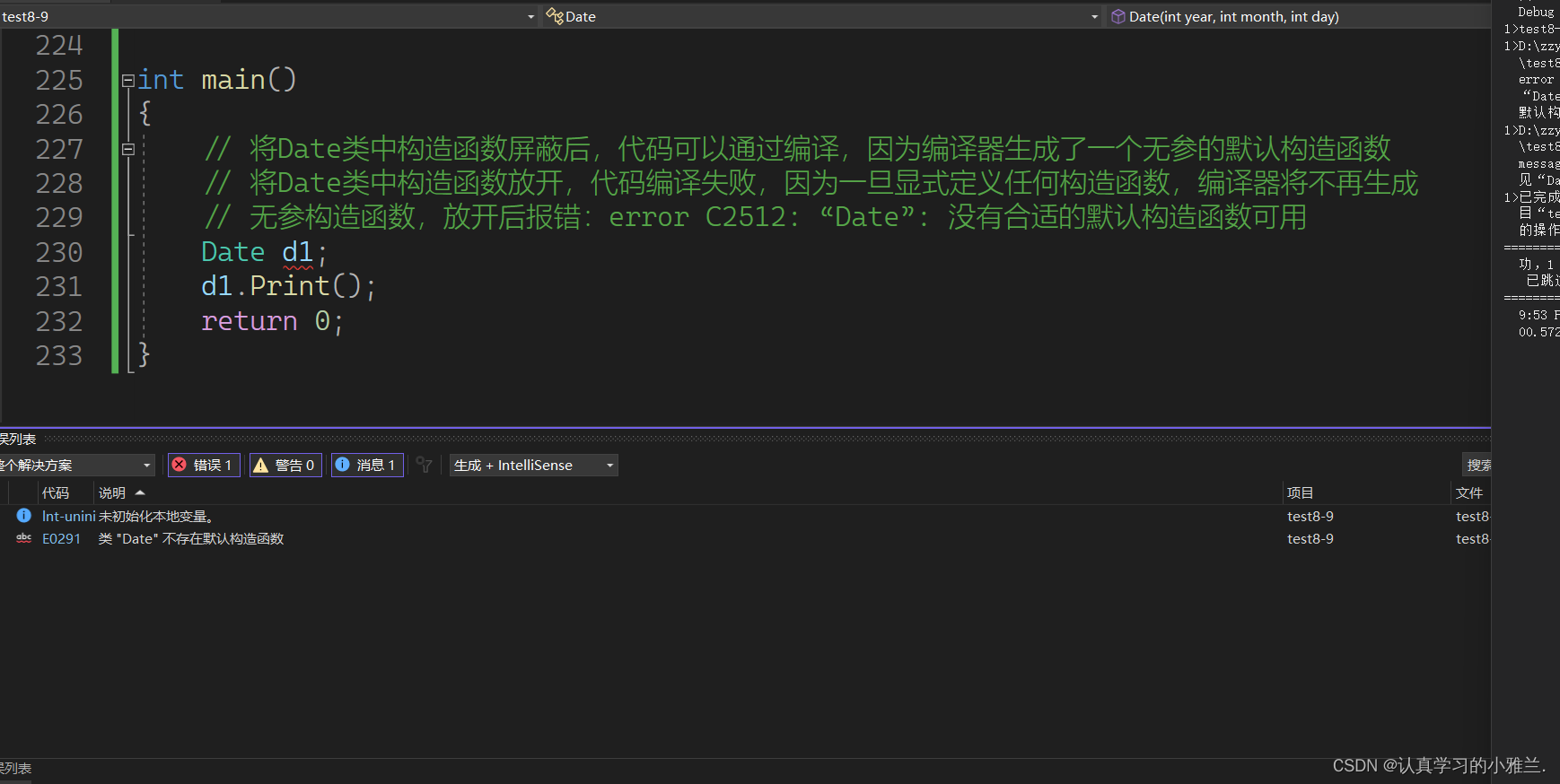
所以,默认生成的构造函数一般没什么价值,但是在有一些场景下非常有价值,之前小雅兰写过一个题目,就是两个栈实现一个队列,既可以写构造函数,也可以不写。
// 两个栈实现一个队列 class MyQueue { private: Stack _pushst; Stack _popst; };总结:一般情况都需要我们自己写构造函数,决定初始化方式
成员变量全是自定义类型,可以考虑不写构造函数
关于编译器生成的默认成员函数,很多人会有疑惑:不实现构造函数的情况下,编译器会 生成默认的构造函数。但是看起来默认构造函数又没什么用?d对象调用了编译器生成的默 认构造函数,但是d对象_year/_month/_day,依旧是随机值。也就说在这里编译器生成的默认构造函数并没有什么用??
解答:C++把类型分成内置类型(基本类型)和自定义类型。内置类型就是语言提供的数据类 型,如:int/char...,自定义类型就是我们使用class/struct/union等自己定义的类型,看看 下面的程序,就会发现编译器生成默认的构造函数会对自定类型成员_t调用的它的默认构造函数。
int*和Date*(指针)都是内置类型!!!
class Time { public: Time() { cout << "Time()" << endl; _hour = 0; _minute = 0; _second = 0; } private: int _hour; int _minute; int _second; }; class Date { private: // 基本类型(内置类型) int _year; int _month; int _day; // 自定义类型 Time _t; }; int main() { Date d; return 0; }
注意:C++11 中针对内置类型成员不初始化的缺陷,又打了补丁,即:内置类型成员变量在 类中声明时可以给默认值。
class Time { public: Time() { cout << "Time()" << endl; _hour = 0; _minute = 0; _second = 0; } private: int _hour; int _minute; int _second; }; class Date { private: // 基本类型(内置类型) int _year = 1970; int _month = 1; int _day = 1; // 自定义类型 Time _t; }; int main() { Date d; return 0; }
无参的构造函数和全缺省的构造函数都称为默认构造函数,并且默认构造函数只能有一个。 注意:无参构造函数、全缺省构造函数、我们没写编译器默认生成的构造函数,都可以认为 是默认构造函数。
不传参就可以调用的构造就是默认构造!!!
class Date { public: Date() { _year = 1900; _month = 1; _day = 1; } Date(int year = 1900, int month = 1, int day = 1) { _year = year; _month = month; _day = day; } private: int _year; int _month; int _day; }; // 以下测试函数能通过编译吗? void Test() { Date d1; } int main() { Test(); return 0; }上述代码是无法通过编译的。
如果是把无参构造函数屏蔽掉或者是把全缺省构造函数屏蔽掉,就可以通过编译了!!!!
析构函数
概念
通过前面构造函数的学习,我们知道一个对象是怎么来的,那一个对象又是怎么没呢的?
析构函数:与构造函数功能相反,析构函数不是完成对对象本身的销毁,局部对象销毁工作是由 编译器完成的。而对象在销毁时会自动调用析构函数,完成对象中资源的清理工作。
也就是说,析构函数类比于Destroy函数!!!
特性
析构函数是特殊的成员函数,其特征如下:
- 析构函数名是在类名前加上字符 ~。
- 无参数无返回值类型。
- 一个类只能有一个析构函数。若未显式定义,系统会自动生成默认的析构函数。注意:析构 函数不能重载。
- 对象生命周期结束时,C++编译系统系统自动调用析构函数。
默认的析构函数跟默认构造函数类似:内置类型成员不会处理,自定义类型成员会调用这个成员的析构函数。
class Date { public: Date(int year = 1, int month = 1, int day = 1) { cout << "Date(int year = 1, int month = 1, int day = 1)" << endl; _year = year; _month = month; _day = day; } void Print() { cout << _year << "/" << _month << "/" << _day << endl; } ~Date() { cout << "~Date()" << endl; } private: int _year = 1; // 声明给的缺省值 int _month = 1; int _day = 1; }; class Stack { public: Stack(size_t n = 4) { cout << "Stack(size_t n = 4)" << endl; if (n == 0) { a = nullptr; top = capacity = 0; } else { a = (int*)malloc(sizeof(int) * n); if (a == nullptr) { perror("realloc fail"); exit(-1); } top = 0; capacity = n; } } ~Stack() { cout << "~Stack()" << endl; free(a); a = nullptr; top = capacity = 0; } void Push(int x) { if (top == capacity) { size_t newcapacity = capacity == 0 ? 4 : capacity * 2; int* tmp = (int*)realloc(a, sizeof(int) * newcapacity); if (tmp == nullptr) { perror("realloc fail"); exit(-1); } if (tmp == a) { cout << capacity << "原地扩容" << endl; } else { cout << capacity << "异地扩容" << endl; } a = tmp; capacity = newcapacity; } a[top++] = x; } int Top() { return a[top - 1]; } void Pop() { assert(top > 0); --top; } void Destroy() { free(a); a = nullptr; top = capacity = 0; } bool Empty() { return top == 0; } private: // 成员变量 int* a; int top; int capacity; }; // 两个栈实现一个队列 class MyQueue { private: Stack _pushst; Stack _popst; }; int main() { Date d1; Date d2; Stack st1; Stack st2; return 0; }
其实日期类不需要写析构函数!!!
像栈这样的数据结构,就需要写析构函数!!!
关于编译器自动生成的析构函数,是否会完成一些事情呢?下面的程序我们会看到,编译器 生成的默认析构函数,对自定类型成员调用它的析构函数。
如果类中没有申请资源时,析构函数可以不写,直接使用编译器生成的默认析构函数,比如
Date类;有资源申请时,一定要写,否则会造成资源泄漏,比如Stack类。
class Time { public: ~Time() { cout << "~Time()" << endl; } private: int _hour; int _minute; int _second; }; class Date { private: // 基本类型(内置类型) int _year = 1970; int _month = 1; int _day = 1; // 自定义类型 Time _t; }; int main() { Date d; return 0; } // 程序运行结束后输出:~Time() // 在main函数中根本没有直接创建Time类的对象,为什么最后会调用Time类的析构函数? // 因为:main方法中创建了Date对象d,而d中包含4个成员变量,其中_year, _month, _day三个是 // 内置类型成员,销毁时不需要资源清理,最后系统直接将其内存回收即可;而_t是Time类对象,所以在 // d销毁时,要将其内部包含的Time类的_t对象销毁,所以要调用Time类的析构函数。但是:main函数 // 中不能直接调用Time类的析构函数,实际要释放的是Date类对象,所以编译器会调用Date类的析构函 // 数,而Date没有显式提供,则编译器会给Date类生成一个默认的析构函数,目的是在其内部调用Time // 类的析构函数,即当Date对象销毁时,要保证其内部每个自定义对象都可以正确销毁 // main函数中并没有直接调用Time类析构函数,而是显式调用编译器为Date类生成的默认析构函数 // 注意:创建哪个类的对象则调用该类的析构函数,销毁那个类的对象则调用该类的析构函数
拷贝构造函数
概念
在现实生活中,可能存在一个与你一样的自己,我们称其为双胞胎。

那在创建对象时,可否创建一个与已存在对象一模一样的新对象呢?
拷贝构造函数:只有单个形参,该形参是对本类类型对象的引用(一般常用const修饰),在用已存 在的类类型对象创建新对象时由编译器自动调用。
特征
拷贝构造函数也是特殊的成员函数,其特征如下:
- 拷贝构造函数是构造函数的一个重载形式。
- 拷贝构造函数的参数只有一个且必须是类类型对象(同类型的对象)的引用,使用传值方式编译器直接报错, 因为会引发无穷递归调用。
class Date { public: Date(int year = 1900, int month = 1, int day = 1) { _year = year; _month = month; _day = day; } // Date(const Date& d)// 正确写法 Date(const Date d)// 错误写法:编译报错,会引发无穷递归 { _year = d._year; _month = d._month; _day = d._day; } private: int _year; int _month; int _day; }; int main() { Date d1; Date d2(d1); return 0; }
class Date { public: Date(int year = 1, int month = 1, int day = 1) { _year = year; _month = month; _day = day; } Date(Date& d) { cout << "Date(Date& d)" << endl; _year = d._year; _month = d._month; _day = d._day; } void Print() { cout << _year << "/" << _month << "/" << _day << endl; } private: // 内置类型 int _year; int _month; int _day; }; typedef int DataType; class Stack { public: Stack(size_t capacity = 3) { _array = (DataType*)malloc(sizeof(DataType) * capacity); if (NULL == _array) { perror("malloc申请空间失败!!!"); return; } _capacity = capacity; _size = 0; } Stack(Stack& s) { cout << "Stack(Stack& s)" << endl; // 深拷贝 _array = (DataType*)malloc(sizeof(DataType) * s._capacity); if (NULL == _array) { perror("malloc申请空间失败!!!"); return; } memcpy(_array, s._array, sizeof(DataType) * s._size); _size = s._size; _capacity = s._capacity; } void Push(DataType data) { _array[_size] = data; _size++; } ~Stack() { cout << "~Stack()" << endl; free(_array); _array = nullptr; _size = _capacity = 0; } private: // 内置类型 DataType* _array; int _capacity; int _size; }; void func1(Date d) { d.Print(); } // 期望呢,s要插入一些数据,s的改变,不影响s1 void func2(Stack s) { s.Push(1); s.Push(2); } int main() { Date d1(2023, 7, 21); func1(d1); Stack s1; func2(s1); Stack s2(s1); // 以下两个写法是等价的,都是拷贝构造 Date d2(d1); Date d3 = d1; return 0; }


若未显式定义,编译器会生成默认的拷贝构造函数。 默认的拷贝构造函数对象按内存存储按 字节序完成拷贝,这种拷贝叫做浅拷贝,或者值拷贝。
class Time { public: Time() { _hour = 1; _minute = 1; _second = 1; } Time(const Time& t) { _hour = t._hour; _minute = t._minute; _second = t._second; cout << "Time::Time(const Time&)" << endl; } private: int _hour; int _minute; int _second; }; class Date { private: // 基本类型(内置类型) int _year = 1970; int _month = 1; int _day = 1; // 自定义类型 Time _t; }; int main() { Date d1; // 用已经存在的d1拷贝构造d2,此处会调用Date类的拷贝构造函数 // 但Date类并没有显式定义拷贝构造函数,则编译器会给Date类生成一个默认的拷贝构造函数 Date d2(d1); return 0; }
注意:在编译器生成的默认拷贝构造函数中,内置类型是按照字节方式直接拷贝的,而自定 义类型是调用其拷贝构造函数完成拷贝的。
我们不写,编译默认生成的拷贝构造,跟之前的构造函数特性不一样
- 内置类型, 值拷贝
- 自定义的类型,调用它的拷贝
总结:Date不需要我们实现拷贝构造,默认生成就可以用
Stack需要我们自己实现深拷贝的拷贝构造,默认生成会出问题
MyQueue对于默认生成的几个函数非常受用,人生赢家
class MyQueue
{
private:
Stack _pushst;
Stack _popst;
};MyQueue mq1;
MyQueue mq2 = mq1;

编译器生成的默认拷贝构造函数已经可以完成字节序的值拷贝了,还需要自己显式实现吗? 当然像日期类这样的类是没必要的。那么下面的类呢?验证一下试试?
// 这里会发现下面的程序会崩溃掉?这里就需要我们以后学的深拷贝去解决。 typedef int DataType; class Stack { public: Stack(size_t capacity = 10) { _array = (DataType*)malloc(capacity * sizeof(DataType)); if (nullptr == _array) { perror("malloc申请空间失败"); return; } _size = 0; _capacity = capacity; } void Push(const DataType& data) { // CheckCapacity(); _array[_size] = data; _size++; } ~Stack() { if (_array) { free(_array); _array = nullptr; _capacity = 0; _size = 0; } } private: DataType* _array; size_t _size; size_t _capacity; }; int main() { Stack s1; s1.Push(1); s1.Push(2); s1.Push(3); s1.Push(4); Stack s2(s1); return 0; }
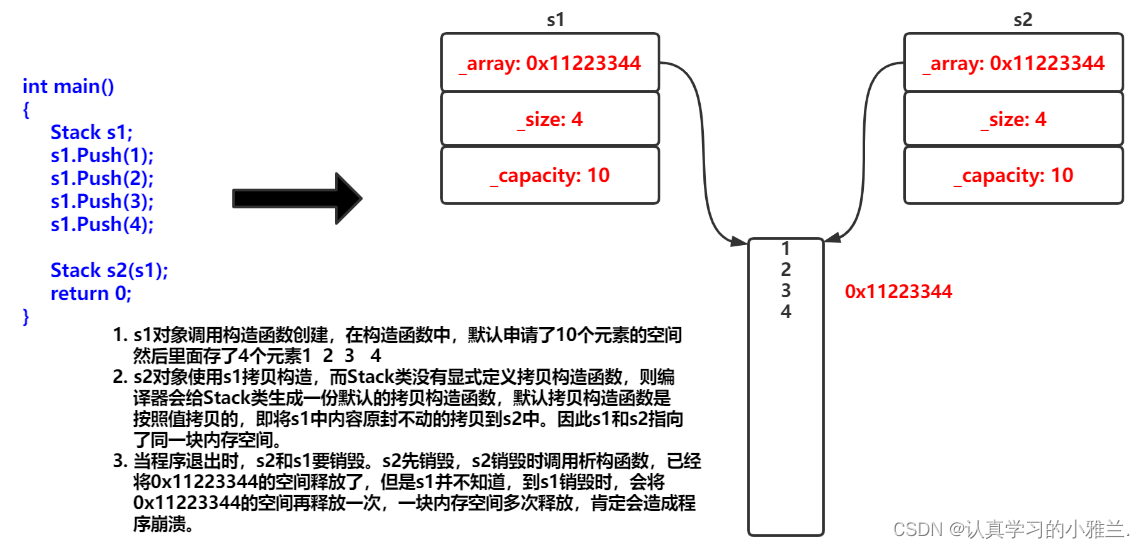
注意:类中如果没有涉及资源申请时,拷贝构造函数是否写都可以;一旦涉及到资源申请 时,则拷贝构造函数是一定要写的,否则就是浅拷贝。
拷贝构造函数典型调用场景:
- 使用已存在对象创建新对象
- 函数参数类型为类类型对象
- 函数返回值类型为类类型对象
class Date
{
public:
Date(int year, int minute, int day)
{
cout << "Date(int,int,int):" << this << endl;
}
Date(const Date& d)
{
cout << "Date(const Date& d):" << this << endl;
}
~Date()
{
cout << "~Date():" << this << endl;
}
private:
int _year;
int _month;
int _day;
};
Date Test(Date d)
{
Date temp(d);
return temp;
}
int main()
{
Date d1(2022, 1, 13);
Test(d1);
return 0;
}
为了提高程序效率,一般对象传参时,尽量使用引用类型,返回时根据实际场景,能用引用尽量使用引用。
所有源代码如下:
#include<iostream>
#include<assert.h>
using namespace std;
class Date
{
public:
void Init(int year, int month, int day)
{
_year = year;
_month = month;
_day = day;
}
void Print()
{
cout << _year << "-" << _month << "-" << _day << endl;
}private:
int _year;
int _month;
int _day;
};int main()
{
Date d1;
d1.Init(2023, 8, 9);
d1.Print();
Date d2;
d2.Init(2023, 8, 10);
d2.Print();
return 0;
}
class Date
{
public:
无参构造函数
//Date()
//{
// cout << "Date()" << endl;
// _year = 1;
// _month = 1;
// _day = 1;
//}
带参构造函数
//Date(int year, int month, int day)
//{
// cout << "Date(int year, int month, int day)" << endl;
// _year = year;
// _month = month;
// _day = day;
//}
//带参构造函数
Date(int year = 1, int month = 1, int day = 1)
{
cout << "Date(int year, int month, int day)" << endl;
_year = year;
_month = month;
_day = day;
}
void Print()
{
cout << _year << "-" << _month << "-" << _day << endl;
}
private:
int _year;
int _month;
int _day;
};
int main()
{
// 调用无参构造函数
Date d1;
d1.Print();
// 调用带参的构造函数
Date d2(2023, 8, 9);
d2.Print();
// 注意:如果通过无参构造函数创建对象时,对象后面不用跟括号,否则就成了函数声明
// 以下代码的函数:声明了d3函数,该函数无参,返回一个日期类型的对象
// warning C4930: “Date d3(void)”: 未调用原型函数(是否是有意用变量定义的?)
//Date d3();
//d3.Print();
Date d3(2023);
d3.Print();
Date d4(2023, 8);
d4.Print();
return 0;
}
class Stack
{
public:
Stack(size_t n = 4)
{
if (n == 0)
{
a = nullptr;
top = capacity = 0;
}
else
{
a = (int*)malloc(sizeof(int) * n);
if(a == nullptr)
{
perror("realloc fail");
exit(-1);
}top = 0;
capacity = n;
}
}
void Push(int x)
{
if (top == capacity)
{
size_t newcapacity = capacity == 0 ? 4 : capacity * 2;
int* tmp = (int*)realloc(a, sizeof(int) * newcapacity);
if (tmp == nullptr)
{
perror("realloc fail");
exit(-1);
}
if (tmp == a)
{
cout << capacity << "原地扩容" << endl;
}
else
{
cout << capacity << "异地扩容" << endl;
}a = tmp;
capacity = newcapacity;
}a[top++] = x;
}int Top()
{
return a[top - 1];
}void Pop()
{
assert(top > 0);
--top;
}void Destroy()
{
free(a);
a = nullptr;
top = capacity = 0;
}bool Empty()
{
return top == 0;
}
private:
// 成员变量
int* a;
int top;
int capacity;
};int main()
{
Stack st1;
st1.Push(1);
st1.Push(2);
st1.Push(3);
st1.Push(4);
while (!st1.Empty())
{
cout << st1.Top() << " ";
st1.Pop();
}
cout << endl;st1.Destroy();
Stack st2(1000);
//Stack st2;
for (size_t i = 0; i < 1000; i++)
{
st2.Push(i);
}while (!st2.Empty())
{
cout << st2.Top() << " ";
st2.Pop();
}
cout << endl;st2.Destroy();
return 0;
}
class Date
{
public:
如果用户显式定义了构造函数,编译器将不再生成
//Date(int year, int month, int day)
//{
// _year = year;
// _month = month;
// _day = day;
//}
void Print()
{
cout << _year << "-" << _month << "-" << _day << endl;
}private:
int _year;
int _month;
int _day;
};int main()
{
// 将Date类中构造函数屏蔽后,代码可以通过编译,因为编译器生成了一个无参的默认构造函数
// 将Date类中构造函数放开,代码编译失败,因为一旦显式定义任何构造函数,编译器将不再生成
// 无参构造函数,放开后报错:error C2512: “Date”: 没有合适的默认构造函数可用
Date d1;
d1.Print();
return 0;
}// 构造函数,也是默认成员函数,我们不写,编译器会自动生成
// 编译生成的默认构造的特点:
// 1、我们不写才会生成,我们写了任意一个构造函数就不会生成了
// 2、内置类型的成员不会处理(C++11,声明支持给缺省值)
// 3、自定义类型的成员才会处理,回去调用这个成员的默认构造函数// 总结:一般情况都需要我们自己写构造函数,决定初始化方式
// 成员变量全是自定义类型,可以考虑不写构造函数
class Time
{
public:
Time()
{
cout << "Time()" << endl;
_hour = 0;
_minute = 0;
_second = 0;
}private:
int _hour;
int _minute;
int _second;
};class Date
{
private:
// 基本类型(内置类型)
int _year;
int _month;
int _day;
// 自定义类型
Time _t;
};int main()
{
Date d;
return 0;
}
class Time
{
public:
Time()
{
cout << "Time()" << endl;
_hour = 0;
_minute = 0;
_second = 0;
}
private:
int _hour;
int _minute;
int _second;
};class Date
{
private:
// 基本类型(内置类型)
int _year = 1970;
int _month = 1;
int _day = 1;
// 自定义类型
Time _t;
};int main()
{
Date d;
return 0;
}
class Date
{
public:
Date()
{
_year = 1900;
_month = 1;
_day = 1;
}
Date(int year = 1900, int month = 1, int day = 1)
{
_year = year;
_month = month;
_day = day;
}private:
int _year;
int _month;
int _day;
};// 以下测试函数能通过编译吗?
void Test()
{
Date d1;
}
int main()
{
Test();
return 0;
}
class Date
{
public:
Date(int year = 1, int month = 1, int day = 1)
{
cout << "Date(int year = 1, int month = 1, int day = 1)" << endl;_year = year;
_month = month;
_day = day;
}
void Print()
{
cout << _year << "/" << _month << "/" << _day << endl;
}~Date()
{
cout << "~Date()" << endl;
}private:
int _year = 1; // 声明给的缺省值
int _month = 1;
int _day = 1;
};class Stack
{
public:
Stack(size_t n = 4)
{
cout << "Stack(size_t n = 4)" << endl;if (n == 0)
{
a = nullptr;
top = capacity = 0;
}
else
{
a = (int*)malloc(sizeof(int) * n);
if (a == nullptr)
{
perror("realloc fail");
exit(-1);
}top = 0;
capacity = n;
}
}~Stack()
{
cout << "~Stack()" << endl;
free(a);
a = nullptr;
top = capacity = 0;
}void Push(int x)
{
if (top == capacity)
{
size_t newcapacity = capacity == 0 ? 4 : capacity * 2;
int* tmp = (int*)realloc(a, sizeof(int) * newcapacity);
if (tmp == nullptr)
{
perror("realloc fail");
exit(-1);
}
if (tmp == a)
{
cout << capacity << "原地扩容" << endl;
}
else
{
cout << capacity << "异地扩容" << endl;
}a = tmp;
capacity = newcapacity;
}a[top++] = x;
}int Top()
{
return a[top - 1];
}void Pop()
{
assert(top > 0);
--top;
}void Destroy()
{
free(a);
a = nullptr;
top = capacity = 0;
}bool Empty()
{
return top == 0;
}
private:
// 成员变量
int* a;
int top;
int capacity;
};// 两个栈实现一个队列
class MyQueue
{
private:
Stack _pushst;
Stack _popst;
};
int main()
{
Date d1;
Date d2;Stack st1;
Stack st2;
return 0;
}
class Time
{
public:
~Time()
{
cout << "~Time()" << endl;
}
private:
int _hour;
int _minute;
int _second;
};class Date
{
private:
// 基本类型(内置类型)
int _year = 1970;
int _month = 1;
int _day = 1;// 自定义类型
Time _t;
};int main()
{
Date d;
return 0;
}// 程序运行结束后输出:~Time()
// 在main函数中根本没有直接创建Time类的对象,为什么最后会调用Time类的析构函数?
// 因为:main方法中创建了Date对象d,而d中包含4个成员变量,其中_year, _month, _day三个是
// 内置类型成员,销毁时不需要资源清理,最后系统直接将其内存回收即可;而_t是Time类对象,所以在
// d销毁时,要将其内部包含的Time类的_t对象销毁,所以要调用Time类的析构函数。但是:main函数
// 中不能直接调用Time类的析构函数,实际要释放的是Date类对象,所以编译器会调用Date类的析构函
// 数,而Date没有显式提供,则编译器会给Date类生成一个默认的析构函数,目的是在其内部调用Time
// 类的析构函数,即当Date对象销毁时,要保证其内部每个自定义对象都可以正确销毁
// main函数中并没有直接调用Time类析构函数,而是显式调用编译器为Date类生成的默认析构函数
// 注意:创建哪个类的对象则调用该类的析构函数,销毁那个类的对象则调用该类的析构函数
class Date
{
public:
Date(int year = 1, int month = 1, int day = 1)
{
_year = year;
_month = month;
_day = day;
}Date(Date& d)
{
cout << "Date(Date& d)" << endl;_year = d._year;
_month = d._month;
_day = d._day;
}void Print()
{
cout << _year << "/" << _month << "/" << _day << endl;
}
private:
// 内置类型
int _year;
int _month;
int _day;
};typedef int DataType;
class Stack
{
public:
Stack(size_t capacity = 3)
{
_array = (DataType*)malloc(sizeof(DataType) * capacity);
if (NULL == _array)
{
perror("malloc申请空间失败!!!");
return;
}_capacity = capacity;
_size = 0;
}Stack(Stack& s)
{
cout << "Stack(Stack& s)" << endl;
// 深拷贝
_array = (DataType*)malloc(sizeof(DataType) * s._capacity);
if (NULL == _array)
{
perror("malloc申请空间失败!!!");
return;
}memcpy(_array, s._array, sizeof(DataType) * s._size);
_size = s._size;
_capacity = s._capacity;
}void Push(DataType data)
{
_array[_size] = data;
_size++;
}~Stack()
{
cout << "~Stack()" << endl;
free(_array);
_array = nullptr;
_size = _capacity = 0;
}
private:
// 内置类型
DataType* _array;
int _capacity;
int _size;
};void func1(Date d)
{
d.Print();
}
// 期望呢,s要插入一些数据,s的改变,不影响s1
void func2(Stack s)
{
s.Push(1);
s.Push(2);
}int main()
{
Date d1(2023, 7, 21);
func1(d1);Stack s1;
func2(s1);Stack s2(s1);
// 以下两个写法是等价的,都是拷贝构造
Date d2(d1);
Date d3 = d1;
return 0;
}
class Date
{
public:
Date(int year = 1900, int month = 1, int day = 1)
{
_year = year;
_month = month;
_day = day;
}
// Date(const Date& d)// 正确写法
Date(const Date& d)// 错误写法:编译报错,会引发无穷递归
{
_year = d._year;
_month = d._month;
_day = d._day;
}
private:
int _year;
int _month;
int _day;
};int main()
{
Date d1;
Date d2(d1);
return 0;
}
class Time
{
public:
Time()
{
_hour = 1;
_minute = 1;
_second = 1;
}
Time(const Time& t)
{
_hour = t._hour;
_minute = t._minute;
_second = t._second;
cout << "Time::Time(const Time&)" << endl;
}
private:
int _hour;
int _minute;
int _second;
};class Date
{
private:
// 基本类型(内置类型)
int _year = 1970;
int _month = 1;
int _day = 1;// 自定义类型
Time _t;
};int main()
{
Date d1;
// 用已经存在的d1拷贝构造d2,此处会调用Date类的拷贝构造函数
// 但Date类并没有显式定义拷贝构造函数,则编译器会给Date类生成一个默认的拷贝构造函数
Date d2(d1);
return 0;
}// 这里会发现下面的程序会崩溃掉?这里就需要我们以后学的深拷贝去解决。
typedef int DataType;
class Stack
{
public:
Stack(size_t capacity = 10)
{
_array = (DataType*)malloc(capacity * sizeof(DataType));
if (nullptr == _array)
{
perror("malloc申请空间失败");
return;
}
_size = 0;
_capacity = capacity;
}
void Push(const DataType& data)
{
// CheckCapacity();
_array[_size] = data;
_size++;
}
~Stack()
{
if (_array)
{
free(_array);
_array = nullptr;
_capacity = 0;
_size = 0;
}
}private:
DataType* _array;
size_t _size;
size_t _capacity;
};int main()
{
Stack s1;
s1.Push(1);
s1.Push(2);
s1.Push(3);
s1.Push(4);
Stack s2(s1);
return 0;
}class Date
{
public:
Date(int year, int minute, int day)
{
cout << "Date(int,int,int):" << this << endl;
}
Date(const Date& d)
{
cout << "Date(const Date& d):" << this << endl;
}
~Date()
{
cout << "~Date():" << this << endl;
}
private:
int _year;
int _month;
int _day;
};
Date Test(Date d)
{
Date temp(d);
return temp;
}
int main()
{
Date d1(2022, 1, 13);
Test(d1);
return 0;
}
好啦,小雅兰今天的学习内容就到这里啦,还要继续加油噢!!!!


